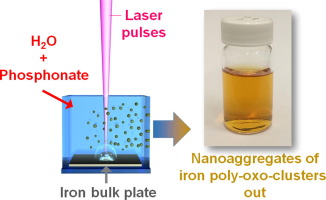Journal of Colloid and Interface Science ( IF 9.9 ) Pub Date : 2018-03-20 , DOI: 10.1016/j.jcis.2018.03.065 Giulio Fracasso , Paolo Ghigna , Luca Nodari , Stefano Agnoli , Denis Badocco , Paolo Pastore , Elena Nicolato , Pasquina Marzola , Dušan Mihajlović , Milan Markovic , Miodrag Čolić , Vincenzo Amendola

|
Laser ablation in liquid (LAL) emerged as a versatile technique for the synthesis of nanoparticles with various structures and compositions, although the control over products remains challenging in most cases. For instance, it is still difficult to drive the size of metal oxide crystalline domains down to the level of few atom clusters with LAL. Here we demonstrate that laser ablation of a bulk iron target in aqueous solution of phosphonates gives phosphonate-grafted iron oxo-clusters polymerized into nanoaggregates with Fe:ligand ratio of 2:1, instead of the usual nanocrystalline iron oxides. We attribute this result to the strong ability of phosphonate groups to bind iron oxide clusters and prevent their further growth into crystalline iron oxide. These laser generated poly-oxo-clusters are biocompatible and trackable by magnetic resonance imaging, providing interesting features for use in biological environments, such as nano-vehicles for iron administration. Besides, this method is promising for the generation of atom-scale metal-oxide clusters, which are ubiquitary in chemistry and of interest in biochemistry, catalysis, molecular magnetism and materials science.
中文翻译:

在膦酸酯水溶液中通过激光烧蚀获得的铁多氧簇簇的纳米聚集体
液态激光烧蚀(LAL)作为一种合成具有各种结构和组成的纳米粒子的通用技术应运而生,尽管在大多数情况下,对产品的控制仍然具有挑战性。例如,使用LAL仍然难以将金属氧化物晶域的大小降低到几个原子簇的水平。在这里,我们证明了在膦酸盐的水溶液中激光烧蚀大块铁靶可以使膦酸酯接枝的铁氧基簇聚成Fe:配体比例为2:1的纳米聚集体,而不是通常的纳米晶体氧化铁。我们将此结果归因于膦酸酯基团结合氧化铁簇并阻止其进一步生长为结晶氧化铁的强大能力。这些激光生成的聚氧簇具有生物相容性,并且可以通过磁共振成像进行跟踪,从而为生物环境(例如用于铁管理的纳米车辆)提供了有趣的功能。此外,该方法有望产生原子级的金属氧化物簇,该簇在化学中是普遍存在的,并且在生物化学,催化,分子磁性和材料科学中引起人们的兴趣。



























 京公网安备 11010802027423号
京公网安备 11010802027423号